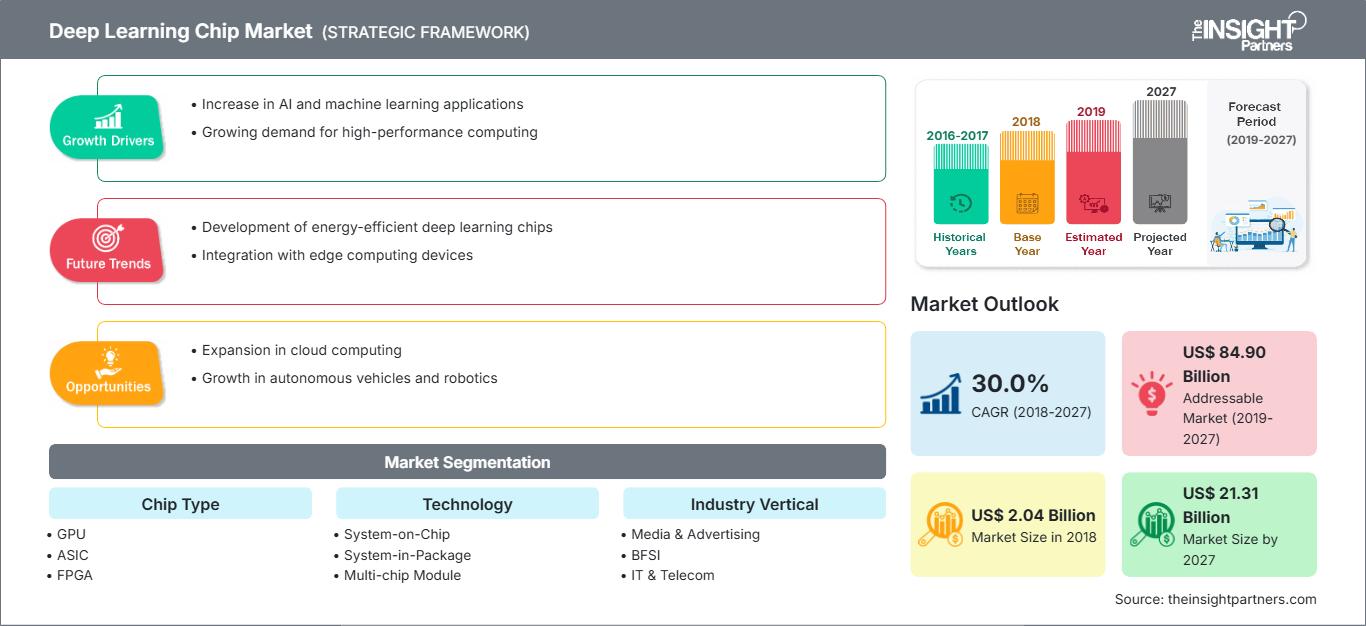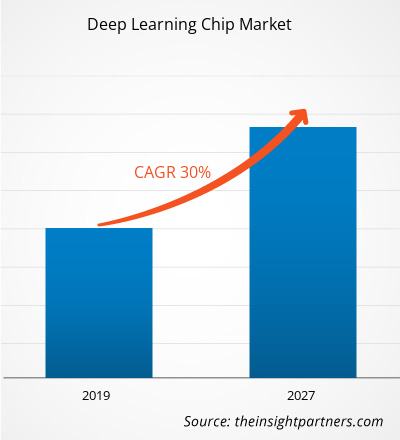Der globale Markt für Deep-Learning-Chips belief sich 2018 auf 2,04 Mrd. USD und soll im Prognosezeitraum 2019–2027 mit einer durchschnittlichen jährlichen Wachstumsrate (CAGR) von 30,0 % wachsen und bis 2027 21,31 Mrd. USD erreichen.
Nordamerika ist der weltweite Markt für Deep-Learning-Chips und wird im gesamten Prognosezeitraum voraussichtlich den höchsten Umsatzbeitrag leisten. Die Entwicklung von Deep-Learning-Chips wird durch massive Investitionen von Technologiegiganten unterstützt, um aus riesigen Mengen generierter Daten Muster zu entwickeln. Der Aufstieg des Quantencomputings und die Implementierung von Deep-Learning-Chips in der Robotik treiben das Wachstum des Marktes für Deep-Learning-Chips in den nordamerikanischen Ländern voran.
Markteinblicke: Die Bedeutung des Quantencomputings trägt zum Wachstum des Marktes für Deep-Learning-Chips bei.
Quantencomputing benötigt Sekunden, um eine Berechnung abzuschließen, die sonst mehr Zeit in Anspruch nehmen würde. Quantencomputer sind eine innovative Transformation von künstlicher Intelligenz, maschinellem Lernen und Big Data. Daher wird erwartet, dass die Bedeutung des Quantencomputings das Wachstum des Marktes für Deep-Learning-Chips vorantreiben wird. Darüber hinaus ist Quantencomputing für verschiedene Faktoren von Vorteil, darunter Portfoliooptimierung, Betrugserkennung und Risikomanagement sowie für Bereiche, in denen sofortiges Datenfeedback erforderlich ist. So ist es für einen einzelnen Prozessor einfacher, komplexe Berechnungen in Sekundenschnelle durchzuführen. Angesichts der Größe des Internets hilft Deep Learning zudem, große Datensätze zu sehr geringen Kosten zu verwalten. Diese Faktoren dürften daher das Wachstum des globalen Marktes für Deep-Learning-Chips ankurbeln.
Passen Sie diesen Bericht Ihren Anforderungen an
Sie erhalten kostenlos Anpassungen an jedem Bericht, einschließlich Teilen dieses Berichts oder einer Analyse auf Länderebene, eines Excel-Datenpakets sowie tolle Angebote und Rabatte für Start-ups und Universitäten.
Markt für Deep-Learning-Chips: Strategische Einblicke

-
Holen Sie sich die wichtigsten Markttrends aus diesem Bericht.Dieses KOSTENLOSE Beispiel umfasst Datenanalysen, die von Markttrends bis hin zu Schätzungen und Prognosen reichen.
Die Geschäftswelt wird immer wettbewerbsintensiver, und um effizient konkurrieren zu können, sind Unternehmen heutzutage auf nützliche Informationen und Geschäftsanalysen angewiesen. Traditionell wurden Geschäftsanalysetools verwendet, um Umsätze auf Grundlage von Daten zu Ereignissen zu prognostizieren, die eine Woche oder einen Monat zurücklagen. Mit dem Aufkommen künstlicher Intelligenz, die in Echtzeit lernt und auf Mustern basierende Empfehlungen liefert, haben Unternehmen eine enorme Chance, Deep Learning in verschiedenen Prozessen anzuwenden, um das Geschäftsumfeld und die Kunden besser zu verstehen.
Unter Berücksichtigung dieser Faktoren ermöglicht künstliche Intelligenz Unternehmen, die Betriebseffizienz zu verbessern, die Betriebskosten zu senken sowie die Servicequalität und das Kundenerlebnis zu verbessern.
Einblicke in Chiptypen
Grafikprozessoren (GPUs) hatten 2018 den größten Marktanteil bei Deep-Learning-Chips, während anwendungsspezifische integrierte Schaltkreise (ASICs) im Prognosezeitraum voraussichtlich das am schnellsten wachsende Segment sein werden. Aufgrund der Tatsache, dass ASICs sehr spezifisch und weniger flexibel sind, stellen sie dennoch eine der leistungsstärksten Hardwareoptionen für Anwendungen der künstlichen Intelligenz dar.
Technologieeinblicke
Zu den Deep-Learning-Chipsätzen gehören System-on-Chip, System-in-Package, Multi-Chip-Module und weitere. Das System-on-Chip-Segment hatte 2018 den größten Marktanteil bei Deep-Learning-Chips, da es hilft, Energieverschwendung, den Platzbedarf großer Systeme und die Kosten zu reduzieren.
Brancheneinblicke
Der globale Markt für Deep-Learning-Chips ist in die Bereiche BFSI, Einzelhandel, IT & Telekommunikation, Automobil & Transport, Gesundheitswesen, Medien & Unterhaltung und Sonstige unterteilt. BFSI hatte den größten Marktanteil bei Deep-Learning-Chips, während das Gesundheitswesen voraussichtlich das am schnellsten wachsende Segment des Marktes sein wird. Faktoren wie die Senkung der Betriebskosten, die Anpassung an sich ändernde Konformitäten und Vorschriften, die Konzentration auf das Kerngeschäft und die Integration von Automatisierung in Geschäftsprozesse sind weitere wichtige Faktoren, die das Wachstum des BFSI-Segments im Markt für Deep-Learning-Chips vorantreiben.
Die Marktteilnehmer auf dem Markt für Deep-Learning-Chips konzentrieren sich hauptsächlich auf Produktverbesserungen durch die Implementierung fortschrittlicher Technologien. Durch den Abschluss von Partnerschaften, Verträgen, Joint Ventures, Finanzierungen und die Eröffnung neuer Niederlassungen auf der ganzen Welt kann das Unternehmen seinen Markennamen global aufrechterhalten. Einige der jüngsten Entwicklungen sind unten aufgeführt:
2019: NVIDIA ist eine Partnerschaft mit Hackster.io eingegangen, um die AI at the Edge Challenge zu starten, einen Wettbewerb, bei dem Entwickler das NVIDIA Jetson Nano Developer Kit zum Erstellen kreativer und einzigartiger Projekte verwenden und Preise im Wert von mindestens 100.000 USD gewinnen können.
2019: Intel kündigte seine Pläne an, das Werk in Oregon zu erweitern, um einen 7-nm-Chip herzustellen. Intels neue Fabrik ist die dritte Phase von D1X, einer riesigen Fabrik, die Intel 2010 in Betrieb nahm. Die ersten beiden Phasen umfassten jeweils 103.000 Quadratmeter und schufen zusammen eine Anlage, die 15 Costco-Filialen entspricht. Die dritte Phase wird die Produktionsfläche von D1X offenbar um etwa 50 Prozent vergrößern. Darüber hinaus will Intel durch die Fabrikerweiterung 60 Prozent schneller auf Chipengpässe reagieren können.
2019: Huawei brachte die HiSecEngine USG12000 auf den Markt, die erste T-Level-AIFW der Branche. Die HiSecEngine USG12000 ist mit Ascend-KI-Chips ausgestattet, die intelligente Erkennungsfunktionen sowie eine intelligente Grenzverteidigung für Unternehmensnetzwerke bieten.
Deep-Learning-Chip
Regionale Einblicke in den Markt für Deep-Learning-ChipsDie Analysten von The Insight Partners haben die regionalen Trends und Faktoren, die den Markt für Deep-Learning-Chips im Prognosezeitraum beeinflussen, ausführlich erläutert. In diesem Abschnitt werden auch die Marktsegmente und die geografische Lage von Deep-Learning-Chips in Nordamerika, Europa, dem asiatisch-pazifischen Raum, dem Nahen Osten und Afrika sowie Süd- und Mittelamerika erörtert.
Umfang des Marktberichts zu Deep-Learning-Chips
| Berichtsattribut | Einzelheiten |
|---|---|
| Marktgröße in 2018 | US$ 2.04 Billion |
| Marktgröße nach 2027 | US$ 21.31 Billion |
| Globale CAGR (2018 - 2027) | 30.0% |
| Historische Daten | 2016-2017 |
| Prognosezeitraum | 2019-2027 |
| Abgedeckte Segmente |
By Chiptyp
|
| Abgedeckte Regionen und Länder |
Nordamerika
|
| Marktführer und wichtige Unternehmensprofile |
|
Dichte der Marktteilnehmer für Deep-Learning-Chips: Auswirkungen auf die Geschäftsdynamik verstehen
Der Markt für Deep-Learning-Chips wächst rasant. Dies wird durch die steigende Endverbrauchernachfrage aufgrund veränderter Verbraucherpräferenzen, technologischer Fortschritte und eines stärkeren Bewusstseins für die Produktvorteile vorangetrieben. Mit der steigenden Nachfrage erweitern Unternehmen ihr Angebot, entwickeln Innovationen, um den Bedürfnissen der Verbraucher gerecht zu werden, und nutzen neue Trends, was das Marktwachstum weiter ankurbelt.

- Holen Sie sich die Markt für Deep-Learning-Chips Übersicht der wichtigsten Akteure
- GPU
- ASIC
- FPGA
- CPU
- Andere
Nach Technologie
- System-on-Chip
- System-in-Package
- Multi-Chip-Modul
- Andere
Nach Branchenvertikale
- Medien & Werbung
- BFSI, IT & Telekommunikation
- Einzelhandel
- Gesundheitswesen
- Automobil & Transport
- Sonstige
Nach Geografie
-
Nordamerika
- USA
- Kanada
- Mexiko
-
Europa
- Frankreich
- Deutschland
- Großbritannien
- Russland
- Italien
- Restliches Europa
-
Asien-Pazifik (APAC)
- Australien
- China
- Indien
- Japan
- Südkorea
- Restliches APAC
-
Naher Osten & Afrika (MEA)
- Saudi-Arabien
- Südafrika
- VAE
- Rest von MEA
-
Südamerika (SAM)
- Brasilien
- Argentinien
- Rest von SAM
Firmenprofile
- Advanced Micro Devices, Inc.
- Alphabet Inc. (Google)
- Amazon.com, Inc.
- Baidu, Inc.
- Huawei Technologies Co., Ltd
- Intel Corporation
- NVIDIA Corporation
- Qualcomm Incorporated
- Samsung Electronics Co., Ltd.
- Xilinx, Inc.
- Historische Analyse (2 Jahre), Basisjahr, Prognose (7 Jahre) mit CAGR
- PEST- und SWOT-Analyse
- Marktgröße Wert/Volumen – Global, Regional, Land
- Branchen- und Wettbewerbslandschaft
- Excel-Datensatz
Aktuelle Berichte
Erfahrungsberichte
Grund zum Kauf
- Fundierte Entscheidungsfindung
- Marktdynamik verstehen
- Wettbewerbsanalyse
- Kundeneinblicke
- Marktprognosen
- Risikominimierung
- Strategische Planung
- Investitionsbegründung
- Identifizierung neuer Märkte
- Verbesserung von Marketingstrategien
- Steigerung der Betriebseffizienz
- Anpassung an regulatorische Trends






















 Kostenlose Probe anfordern für - Markt für Deep-Learning-Chips
Kostenlose Probe anfordern für - Markt für Deep-Learning-Chips